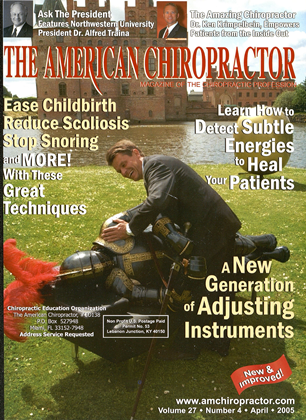The doctor of chiropractic is the only health care professional capable of reducing a scoliosis without braces or surgery. D r. Hugh B. Logan, who founded Logan College of Chiropractic, first developed the basis for this procedure for the correction of scoliosis. Over the last fifty years, I have modified, improved and updated the procedure to allow the chiropractor to produce consistent results. I established the International Scoliosis Research Center to provide research, consultation and seminars to the profession on this subject. The doctor of chiropractic is the only health care professional capable of reducing a scoliosis without braces or surgery. Theory It has been continued clinically that subluxation of the sacrum, both anterior and inferior, predisposes to the development of a scoliosis. The body of the lowest freely movable vertebrae will always rotate to the low side of its foundation. Utilization of the Mawhiney Procedure, utilizing Logan Basic Technique, heel lift application, restrictions and exercise, will reduce the scoliosis in a prescribed period of time. Treatment procedure The treatment is set on a minimum three-month evaluation period, incorpo- rating Logan Basic Technique, bilateral weight scale evaluation, heel lift application, exercises and restrictions, and specific vertebral adjusting. Vertebral adjusting is very specific, because each section of the scoliosis develops in a progressive manor, and the vertebra to be adjusted must be adjusted in proper sequence. Patient is seen three times per week for the first three weeks and then reduced to twice weekly for the next nine weeks. In cases of Grade II scoliosis and above, a hanging X-ray is taken at the initial exam, to determine the extent of scoliosis reduction that can be anticipated in ninety days. The hanging X-ray is achieved by having the patient hang, by their hands, for a two-minute period, and the exposure is made while the patient is suspended. It was proved, in clinical trials, that this procedure will show the actual amount of reduction that may be obtained, which vertebral segments will rotate, and how much reduction will be made in the Cobb's angle. Heel lift application is determined by the sacral inferiority, the lowest freely movable vertebrae and the bilateral weight scales. The heel lift application has nothing to do with a measurable leg length, but only with the sacral inferiority. Ninety-day evaluation should demonstrate a 15% reduction in the scoliosis and the next ninety-day period would have the patient seen twice weekly. In advanced cases, a traction/distraction table would increase the scoliosis reduction expected in ninety days. Each visit would first have the patient checked on the bilateral weight scales, to determine if the lift placement is correct in thickness to support the sacrum. The patient will respond to scoliosis reduction best with the use of an adjustable table such as the Zenith Hy-LO. A flat table does not allow for AP changes in the prone posture necessary to encourage results. The patient will then receive an application of Logan Basic Technique, for approximately five minutes. The contact is always on the low side of the sacrum and is best applied after the patient is manually positioned anatomically in the prone position, to encourage curvature reduction and muscle relaxation. The patient is restricted from all contact sports and any activity that may traumatize the pelvis or sacrum. The only exercise utilized the first thirty days is the hanging exercise, done twice daily. This exercise consists of having the patient hang, by their hands, twice daily for an accumulated time of two minutes. Other exercises, such as free weights, may be added later. Once the heel lift is placed and monitored, the scoliosis will reduce, allowing the Logan Basic Contact, specific vertebral adjusting, restrictions and exercise to control the speed of the reduction. Conclusion Proper chiropractic care has demonstrated, over the last seventy years, to be the only profession to reduce spinal scoliosis without the use of braces or surgery. It is a specialty subject and any chiropractor not properly trained in a college sponsored post-graduate course risks a malpractice problem if the scoliosis increases while the patient is under their care. BET8 Dr. Mawhinev inuv be reached at 25540 Belle llelene. Leeshuiy,. h'L $474H; or by email at rmanhUi aal.com. *The scoliosis manual. Chiropractic Procedures in Spinal Distortion Cases, is available through the author. A hanging X-ray allows the doctor to determine how much reduction is possible without braces or surgery, using conservative measures. Gravity film of scoliosis case, before and after application of Scoliosis Reduction Procedure. Thirty-day Treatment.
 View Full Issue
View Full Issue






